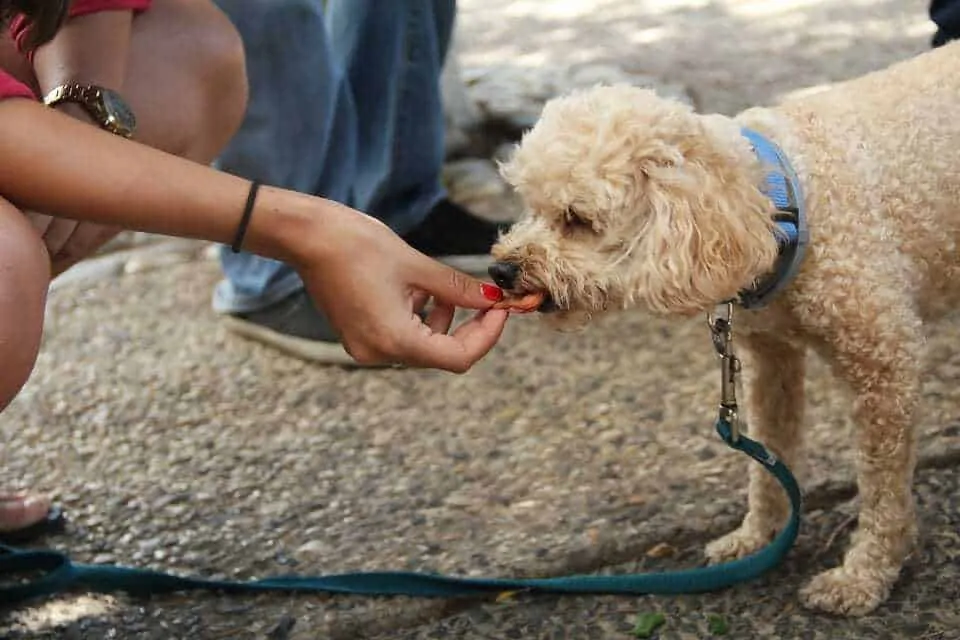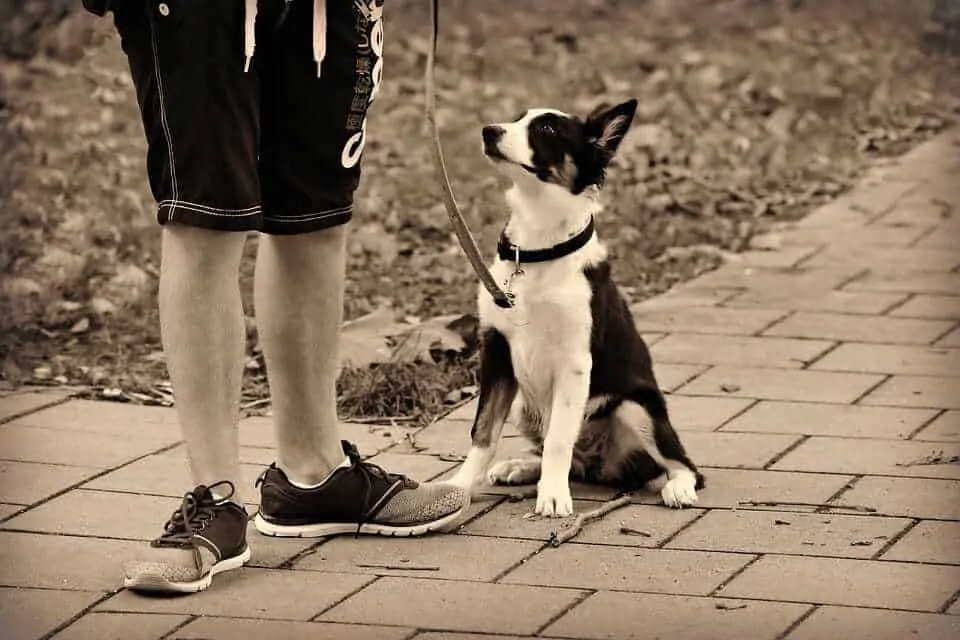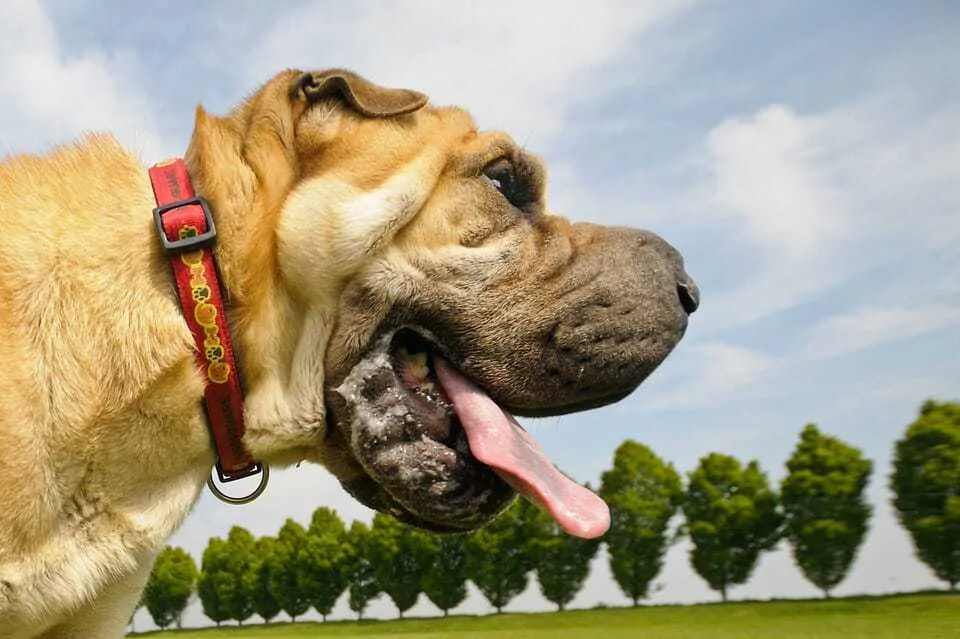Counterconditioning and desensitization are two terms that can be baffling if you are just entering the world of dog training and behavior but, if you are dealing with a nervous or fearful dog, they are ones that it is important to gain an understanding of as they can be very powerful tools, especially when used together, for helping to change your dog’s reaction towards the thing/s that scare them into a positive one.
When dealing with a fearful dog, counterconditioning and desensitization can be a very effective training technique
Contents
What is Counterconditioning?
Counterconditioning (CC) is all about your dog’s emotional response to a particular stimulus. The goal of CC is to change that emotional response. CC is often used for dogs that have an already conditioned fear of fireworks, going to the vet, having contact with strange dogs or people.
Often food rewards will be used to change your dog’s reaction. For example, if they are frightened of other dogs, every time they see one in the future this will be paired with getting a super tasty treat. The more this happens, the more your dog will begin to understand that new dog’s actually mean good things and their response will change from a negative one to a positive one.
Food rewards can be hugely helpful when helping to change your dog’s reaction to a stimulus that has previously been scary for them
What is Desensitization?
If the dog’s emotional response to something is very extreme, often the counterconditioning will only be possible and effective if the exposure to the stimulus that is frightening is very gradually introduced.
If their fear is extreme, they may be too frightened and shut down to take be able to take a food reward and so it would not be possible to help them change their emotional response.
By working on very gradual reintroductions to the fear-invoking stimulus, this means the dog will be more receptive to the counterconditioning techniques and this gradual process is called desensitization.
So, taking the example of the dog that is frightened of other dogs. Often the process of desensitization may need to start from an extremely far away distance. Basically, being far enough away from the other dog to ensure that no negative reaction is triggered. The process of counterconditioning can then begin from this distance, very slowly then building up to closer contact.
For a desensitization process to be successful, very gradual reintroductions to the stimulus is required
Getting Help From a Qualified Dog behaviorist Can Often Be Helpful
While it is possible to work on counterconditioning and desensitization (CC & D) yourself, if the problem is very severe then it can often be beneficial to seek guidance from a qualified behaviorist. It can be vitally important that the pace of the training is not too fast, that the timing of the rewards is just right and that the management of the situations is carefully monitored to avoid any setbacks. Sometimes having an expert there can be helpful and confidence boosting too.
Key Considerations with a Counterconditioning and Desensitization Programme
Understanding the Signs of Fearful behavior
Sometimes a dog can be showing you that they are frightened and you may not be aware, if they are then continually exposed to the stimulus that is frightening them despite this, their reaction can become more pronounced over time.
By understanding the subtle signs your dog is giving you, this can mean that you may be able to step in to tackle this before it becomes a major problem. It also means that, when you do start training, if you start noticing signs of fear, you know that you are moving too far and too fast and you need to take a step back to where your dog is more relaxed.
Some common subtle signals and body language that can show your dog may be feeling fearful, stressed or uncomfortable include:
- Appeasement behaviors such as lip licking, yawning, sniffing, avoiding eye contact
- Panting (even when it is not hot or they have not been exerting themselves)
- Fearful body language like tucked tail, flattened ears, showing the whites of their eyes, hunched or cowering posture
- Defensive body language, like stiff and erect tail, hard stares, raised hackles, lack of movement and being on high alert
- Drooling
- Accidental Urination
- Trembling
- Pacing
- Aggressive behavior like snapping, lunging, growling or even biting
Panting and drooling can be signs of stress or fear
Make Sure You Understand What is Triggering the Negative Reaction in Your Dog
Sometimes it may not always be clear what is making your dog upset. If you then accidentally continue to expose them to this, unaware they are fearful, you can make this worse. It is important to look for the signs of their discomfort, as described above, and then take the time to work out what is making them react like this. Sometimes it is, of course, very obvious but sometimes it could be something like a fear of only certain types of dogs (particular breeds or colours), maybe it is a fear of a very specific noise or environment, maybe of a specific item in the house.
Try To Minimise the Exposure to The Stimulus At First
While you work on a CC & D programme, where possible, it is important to minimise their exposure to the thing that triggers a negative reaction so that you can gradually build things up in a positive way. If in between the training, they continue to be exposed to it full on then the training will not be effective. Sometimes this can be a challenge when you are dealing with unpredictable things, like thunderstorms, for example.
If they have a fear of strange dogs, then try to walk on routes where you are unlikely to meet other dogs, or cross the street to avoid close contact where possible.
If they have a fear of the car, then try to avoid car journeys while you are working on building up more positive associations.
Always Use Extremely Motivating Rewards
When working on extreme cases, it is really important that you choose extremely motivating food rewards, Using some of their dry kibble that they get every day is generally not going to be enough. You want to change their reaction from something negative to something positive so you need to pick something your dog loves and is very motivating for them to help change their attitude. For some dogs, they may be motivated by play, so perhaps getting a short session with their favourite tug toy will be a motivating and rewarding thing for them.
Picking treats that your dog loves is very important when working on counterconditioning
Always Take it Slow
When you are dealing with extreme reactions, it is exceptionally important that you do not try to move too fast or get impatient. Desensitization is usually a very gradual and slow process. Each session should be short and very positive. When you move onto the next stage it should not be a leap but a baby step, so small that your dog will hardly notice it. If you try to progress too far and too fast you could risk having to go right back to square one.
When Can Counterconditioning and Desensitization Be Useful?
We have touched upon some of these already, and there are a whole host more too, but some of the common scenarios for when using a CC & D programme may be useful are outlined below:
Separation Anxiety
For dogs that have severe separation anxiety, using a CC & D programme is often the most successful way to tackle this. It can often be a painfully slow process for the owners but, if you put the work in and have patience, it can really pay off.
For dogs that get stressed as soon as you go out the door, you really need to take it back to absolute basics. Work on having your dog stay settled in their bed or sofa, or wherever they generally relax, even just when you stand up from your sofa space. This may be as simple as repeatedly standing up and then sitting down again. Once they show no signs of stress at this stage, you can then move on to moving around a few steps in the room and then sitting again. From here you would work up to stepping outside the room, even if it is just for five seconds and returning. While you don’t want to make a big fuss when you come back, you can quietly reward your dog if they have stayed in their place.
Once you move on to going out, again this should initially be a number of sessions where you just go out and then come straight back in again, before you work up to more than this. Once your dog is relaxed enough when you are out for a short period of time, you can also introduce more positive associations with you leaving, like yummy treat toys.
For our in-depth article for more information on dealing with separation anxiety.
If your dog is suffering from severe separation anxiety, often a CC & D programme is the most effective way of resolving the issue
Fear-Reactivity Towards Dogs or People
If your dog is fearful of other dogs or people it can be difficult to manage scenarios enough to work on this successfully. Often it can be helpful to employ some “stooge” dogs. This may be through a friend or a dog trainer that has a very calm and unflappable dog.
You can then start at a far enough distance away that your dog is comfortable and does not react. It may be that they are only a spot on the horizon, and that is fine. From this point you would work on rewarding your dog from this distance anytime they look at the dog or person that would normally cause a reaction. Once they are eagerly anticipating a treat for looking at the stimulus from this distance then you could move a few steps forward. If, at any point, you move forward and it triggers a reaction, just move a step back again and work some more at this distance before moving forward just a little less than the last time.
In severe cases, this CC & D programme may have to be built up over a period of weeks or even months. It is also important to gradually work on introducing new stooge dogs or people.
Remember to take it at your dog’s pace, don’t push them too fast and try to limit any uncontrollable interactions that could set you back as much as possible in between training sessions.
For dogs with an extreme aversion to other dogs, you may never get to the point where they are comfortable off leash with strange dogs but, if you can get them to a point where they are happy to pass other dogs on the street without getting super stressed. then this is a win for you both.
Fear of the Car
If your dog is fearful or stressed when on a car journey, sometimes you have to take it back to absolute basics, depending on the level of their anxiety. You may need to just start by letting them approach the car at a distance and then reward them and build up gradually to have them get in and out of the car, then onto sitting in it for short periods without the engine on, then with the engine on, then in and out the drive, then on a very short journey.
Sometimes a dog’s fear of the car could have arisen from what was at the end of the journey (this can be common if they only really go in the car to go to the vet). If this is the case, then you need to start making some journeys where the endpoint is something your dog loves, like the beach or a park.
See our article on helping your dog to be relaxed and safe in the car for more in-depth guidance.
It can also be a useful technique for helping a dog to get over their fear of car journeys
Fear or Fireworks
CC & D programmes are commonly used for dog’s that have phobias of fireworks or thunderstorms. Sadly, many dogs can have extremely fearful reactions towards fireworks and a very slow and extremely gradual exposure is required to help them get over their fear.
Using a fireworks soundtrack can be useful in these instances. This means that the volume of the fireworks sound can start so low that it is almost imperceptible and can be very slowly built up to a higher volume over a period of weeks or months and always paired with tasty treats and lots of things your dog enjoys.
Be aware that, in the most extreme cases, sometimes advice from your vet or behaviorist may be appropriate to find out what other support your dog can have in terms of medication and other training options and tools too. Please see our in-depth article on tips for dealing with a fear of fireworks for more guidance too.

Jen Jones is a professional dog trainer and behavior specialist with more than 25 years of experience. As the founder of ‘Your Dog Advisor’ and the ‘Canine Connection’ rehabilitation center, she applies a holistic, empathetic approach, aiming to address root causes rather than merely treating symptoms.
Well known for her intuitive and compassionate approach, Jen adopts scientifically-proven, reward-based methods, encouraging positive reinforcement over punishment. Jen specializes in obedience training, behavior modification, and puppy socialization. Her innovative methods, particularly in addressing anxiety and aggression issues, have been widely recognized. Jen has worked with many of the world’s leading dog behaviorists and in her free time volunteers with local animal shelters and rescue groups.







